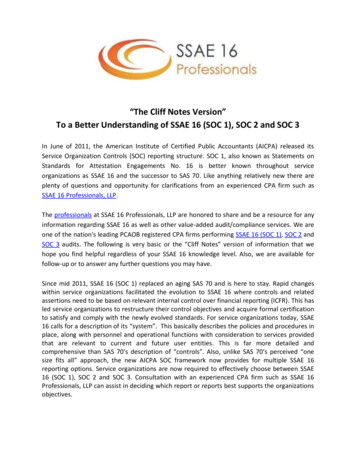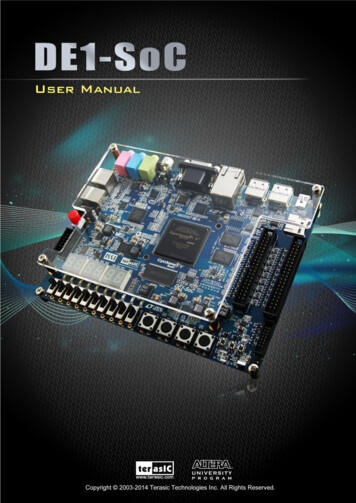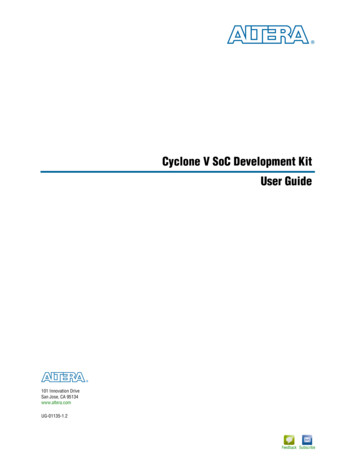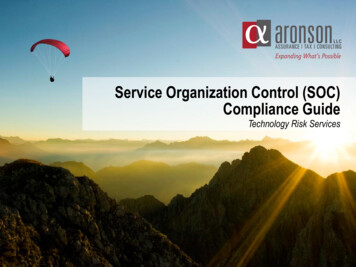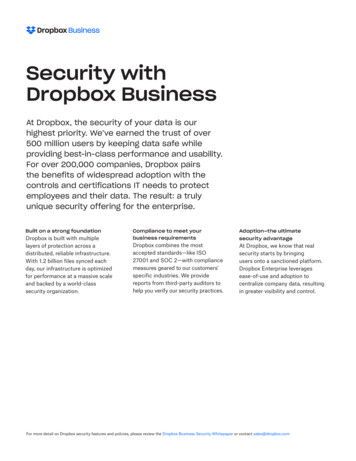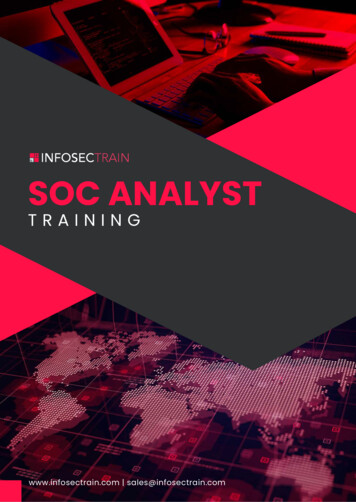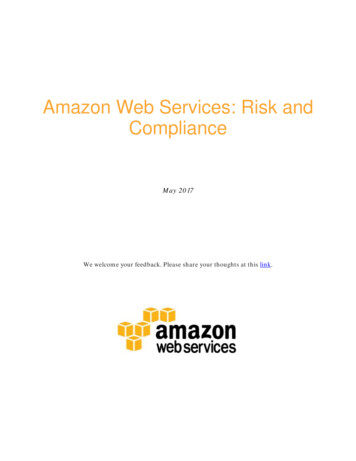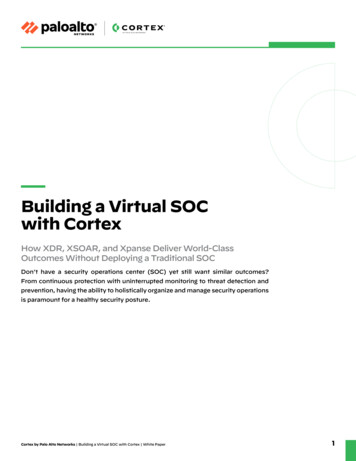
Transcription
Building a Virtual SOCwith CortexHow XDR, XSOAR, and Xpanse Deliver World-ClassOutcomes Without Deploying a Traditional SOCDon’t have a security operations center (SOC) yet still want similar outcomes?From continuous protection with uninterrupted monitoring to threat detection andprevention, having the ability to holistically organize and manage security operationsis paramount for a healthy security posture.Cortex by Palo Alto Networks Building a Virtual SOC with Cortex White Paper1
In addition to increasing attack frequency and sophistication, attacks are becoming more costly, manydriven by the surge in ransomware bolstered by rising cryptocurrency prices. Unfortunately, an attackcan go undetected for a long time, leading to increased dwell times and further delaying investigation,mitigation, or remediation. While reasons for operational inefficiencies differ among organizations,many of them include: Limited visibility into their devices, applications, networks, and systems. Not knowing which assets to protect. Not understanding which tools to use and integrating them with the existing infrastructure.Cortex Is a Holistic Ecosystem for ProactiveSecurity OperationsA solution to address the above challenges is a suite of products that enables tighter control of securityoperations: a holistic ecosystem with a view of the security posture for targeted threat detection,behavioral monitoring, intelligence, asset discovery, and risk assessment—a virtual SOC that can bemanaged without dependencies on a physical location or assets.You can now achieve this reality—SOC virtualization—with the Cortex suite of products: Cortex XDR,Cortex Xpanse, and Cortex XSOAR, which seamlessly work together as a force multiplier across yoursecurity operations regardless of team size or scope.Our ApproachWhile each product brings unique features and benefits, the positive results exponentially increasewhen combined. These three products help lower the risk and impact from breaches with acomprehensive product suite for teams of any size, with best-in-class detection, investigation,automation, and response capabilities, bar none.Scope and protect your attack surfacePreventeverythingyou canEverything you can’tprevent, detect andinvestigate fastAutomate responseand get smarter withevery incidentFigure 1: High-fidelity detections and alerts help drive orchestrated workflowsWith end-to-end native integration and interoperability, security teams can close the loop on threatswith continual synergies across the Cortex ecosystem. All three products work in concert to monitorthe threat landscape and provide the most robust prevention, detection, response, and investigationcapabilities: Cortex XDR provides endpoint security and EDR to block sophisticated attacks usingAI-driven analysis and a range of protection modules. Cortex XDR and Cortex Xpanse provide the ultimate visibility and detections across the internetattack surface, endpoints, cloud, and network. Cortex XDR and Cortex Xpanse leverage Cortex XSOAR for full orchestration, automation, andresponse capabilities. Cortex XSOAR leverages Cortex XDR and Cortex Xpanse to provide high-fidelity detections and alertsto drive orchestrated workflows.Cortex by Palo Alto Networks Building a Virtual SOC with Cortex White Paper2
Cortex XDR for Endpoint Protection and ExtendedDetection and ResponseCortex XDR can stop attacks at the endpoint and host with world-class EDR for Windows and Linuxhosts with: AI-driven local analysis and ML-based behavioral analysis that is updated regularly. A suite of endpoint protection features such as device control, host firewall, and disk encryption. A range of protection modules to protect against pre-execution and post-execution exploits.Once you prevent everything you can at the endpoint, Cortex provides detection and response that focuseson incidents by automating evidence gathering, groups of associated alerts, putting those alerts into atimeline, and revealing the root cause to speed triage and investigations for analysts of all skill ticsIdentityAnalyticsContinuedInnovationStitched and CorrelatedData SourcesEndpointsNetworkCloudIdentityAdditional SourcesFigure 2: Faster detection and response with AI/ML analytics with Cortex XDRThe Next Logical Evolution of EDRThe product vision for extended detection and response (XDR) was created by Nir Zuk, CTO and cofounder of Palo Alto Networks, in 2018. The reason for creating XDR was to stop attacks more efficientlyat the endpoint, detect attacker techniques and tactics that cannot be prevented, and help SOC teamsbetter respond to threats that require investigation. The vision is to automate many of the SOC analysttasks, like writing detection logic, gathering evidence, building an incident from alerts, enriching theincident with identity and threat information, and pulling disparate telemetry together from multiple(and in some cases, complementary) sources, including EDR, network traffic analysis (NTA), user andentity behavior analytics (UEBA), and indicators of compromise (IoCs).XDR lets security teams stop attacks more efficiently and effectively, eliminating blind spots, reducinginvestigation times, and ultimately improving security outcomes using XDR. And with XDR’s abilityto stop attack sequences at critical stages such as execution—before persistence techniques result inbroader lateral damage—security teams finally have a solution to “head attacks off at the pass.”In round 3 of MITRE testing, Cortex XDR’s results against TTPs used by Carbanak and FIN7 blocked100% of attacks in the protection evaluation on both Windows and Linux endpoints and achieved 97%visibility of attack techniques which represents the best detection rates of any solution that also got aperfect protection score.1 Of the attack techniques used, Cortex XDR identified 86% with an analyticsdetection, defined by MITRE as detections that provide additional context beyond telemetry.2 Notice1. Peter Havens, “Cortex XDR: Best Combined Prevention and Detection in MITRE Round 3,” Palo Alto Networks, April 21, /mitre-round-3-protecting-against-carbanak/.2. Ibid.Cortex by Palo Alto Networks Building a Virtual SOC with Cortex White Paper3
those legacy endpoint vendors that only provide EDR/ESS/NG-AV solutions scored poorly in protectionefficacy, visibility, and techniques detection.As an evolution of existing threat detection and response solutions, XDR includes features such as: Integrated threat intelligence Network analysis Machine learning-based detection Investigation response orchestration Dynamic deployment Integrated sandbox capabilities with WildFire Factors driving the adoption of XDR include simplified visualization of complex attacks across thekill chain, presenting information within the MITE ATT&CK framework, more robust automation,advanced analytics, and machine learning.XDR’s value is gaining momentum due to the need in the market for tighter third-party integrations,better analytics, and faster response capabilities—especially when one considers that organizationsmay use up to 45 security tools on average while responding to an incident that requires coordinationacross approximately 19 tools.XDR Fills the Detection and Response VoidBefore XDR, correlating telemetry from endpoints with other event data was an exercise in siftingthrough large volumes of data and false positives cluttering analysts’ dashboards. Stitching disparateevents together is resource-intensive and dependent on seasoned analysts to determine if alertescalations are warranted. As a result, SOC teams could find themselves wasting time verifying theaccuracy of low-fidelity alerts while compromising the time needed to investigate legitimate alerts.Impeded by this nonstop version of security “whack-a-mole” and an increase in attack sophisticationand frequency, forward-thinking security organizations are beginning to take advantage of all theefficiencies gained from an XDR approach to security architecture.According to Forrester analyst Allie Mellen, who covers SecOps, “XDR and SIEM are not converging butcolliding.”3 In a recent blog post, Mellen explains further:XDR combines theSIEM-like featuresof alert integration,normalization,and correlationwith SOAR‑likeautomatedinvestigation andremediation.“XDR will compete head-to-head with security analytics platforms (and SIEMs) for threat detection,investigation, response, and hunting. Security analytics platforms have over a decade of experience indata aggregation; they apply to these challenges but have yet to provide incident response capabilitiesthat are sufficient at enterprise scale, forcing enterprises to prioritize alternate solutions. XDR is risingto fill that void through a distinctly different approach anchored in endpoint and optimization.The core difference between XDR and the SIEM is that XDR detections remain anchored in endpointdetections, as opposed to taking the nebulous approach of applying security analytics to a large set of data.As XDR evolves, expect the vendor definition of endpoint to evolve as well based on where the attackertarget is, regardless of if it takes the form of a laptop, workstation, mobile device, or the cloud.”4Takeaway: XDR can address SIEM use cases by providing threat detection, investigation, response,and hunting rooted in endpoint threat detection and response with the ability to scale to cloudenvironments.Xpanse for Complete, Accurate and ContinuouslyUpdated Inventory of All Global Internet-Facing AssetsCortex Xpanse provides a complete and accurate inventory of an organization’s global, internet-facingcloud assets and misconfigurations to continuously discover, evaluate, and mitigate an external attacksurface and evaluate supplier risk or assess the security of M&A targets.3. Allie Mellen, “XDR Defined: Giving Meaning To Extended Detection And Response,” Forrester, April 28, . Ibid.Cortex by Palo Alto Networks Building a Virtual SOC with Cortex White Paper4
Discovers andreduces the entireattack surface Cross-correlatesinternal viewof assets withoutside-in ticsIdentityAnalyticsContinuedInnovationStitched and Correlated Understandsexposure tonew attacks andhow attackshave unfolded(including supplychain exposuresand nation-statevulnerabilities)Data SourcesEndpointsNetworkCloudIdentityAdditional SourcesFigure 3: Ultimate visibility and detection across the internet attacksurface, endpoints, cloud, and networkIn our recent report, 2021 Cortex Xpanse Attack Surface Threat Report: Lessons in Attack SurfaceManagement from Leading Global Enterprises, Palo Alto Networks outlined some key findings fromtheir research of the public-facing internet attack surfaces of some of the world’s largest businesses.From January to March, their team monitored scans of 50 million IP addresses associated with 50 globalenterprises to understand how quickly adversaries can identify exposed systems for fast exploitation.One interesting discovery was that nearly one in three exposed assets they uncovered was due tounnecessary use of Remote Desktop Protocol (RDP), which has surged in use since early 2020 asenterprises expedited moves to the cloud to support remote workers affected by new WFH protocolsdue to the COVID-19 pandemic. Other findings in the report include: Adversaries scan more frequently than companies. In a game of never-ending “cat and mouse,” threatactors were found to conduct a new scan once every hour, whereas global enterprises can take weeks. Adversaries scan within 15 minutes of new vulnerabilities. Attackers began scanning within 15minutes following announcements of new Common Vulnerabilities and Exposures (CVE) releasedbetween January and March and launched scans within five minutes of the Microsoft Exchange Serverzero-day security update. Exposed systems every 12 hours. Cortex Xpanse discovered that, on average, global enterprisespresent a new serious exposure every 12 hours or twice daily. Issues included insecure remote access(RDP, Telnet, SNMP, VNC, etc.), database servers, and exposures to zero-day vulnerabilities inproducts such as Microsoft Exchange Server and F5 load balancers. Cloud comprised almost 80% of the global enterprise security concerns. Cloud footprints wereresponsible for 79% of the most critical security issues found in global enterprises, reiterating theinherent risk of cloud-hosted/based services, compared to 21% for on-premises.Understanding the Attack SurfaceOne foundational component of a SOC transformation is to have a strong continuous risk managementfunction. Identifying the “things” you are trying to protect and identifying what is exposed that allowsit to be attacked is a logical segue into a risk management process that establishes the context for a riskmanagement plan or strategy, whether basic or more robust. By starting with identification, the abilityto prioritize what’s at risk makes it easier to analyze what it would take to actually mitigate each risk.A critical step to informing any risk management function is to have a clear understanding of one’sattack surface—you can’t protect what you can’t see.Cortex by Palo Alto Networks Building a Virtual SOC with Cortex White Paper5
Your attack surface is made up of Externally FacingOn-Prem AssetsIoT andMobile DevicesInternallyFacing AssetsM&A ITInfrastructureUnsanctionedCloud AssetsInternet AssetsOwned by YouSupply ChainAssetsCloudEnvironmentsFigure 4: Components of your attack surfaceDefined by SANS Institute:Attack surface management (ASM) “is an emerging category of solutions that aims to helporganizations address this challenge by providing an external perspective of an organization’s attacksurface. An organization’s attack surface is made up of all internet-accessible hardware, software, SaaSand cloud assets that are discoverable by an attacker. In short, your attack surface is any external assetthat an adversary could discover, attack, and use to gain a foothold into your environment.”5SANS lists some common use cases for the adoption of an ASM solution, including: Identification of external gaps in visibility Discovery of unknown assets and shadow IT Attack surface risk management Risk-based vulnerability prioritization Assessment of M&A and subsidiary riskYet, whether one chooses to deploy ASM solutions or perform proactive assessments like penetrationtesting or vulnerability scanning, what is clear is the need to identify both product and operationalrequirements to determine the best fit. Product and operational requirements can include functionality,feature(s), capability, and evaluation criteria to help summarize the features and capabilities you mightexpect in an ASM solution or tool.Takeaway: Advancements in scanning technologies allow attackers to locate attack vectors quicklyand easily, revealing abandoned, rogue, or misconfigured assets that can become backdoors forcompromise. Deploying an attack surface management solution is the best way to continuously assessan organization’s external attack surface in a cost-effective, repeatable, and scalable manner.Cortex XSOAR for Security Orchestration, Automation,and ResponseCortex XSOAR provides end-to-end incident and security operational process lifecycle management,helping companies accelerate security operations, reduce the time it takes to investigate and respondto security alerts and incidents, and handle more incidents. Security teams of all sizes can orchestrate,automate, speed incident response and any security workflow or security process across theirenvironment by leveraging the extensive vendor integration and 725 pre-built integration contentpacks to maximize enterprise integration coverage.Companies realize that integrated threat intelligence management, the ability to automatically mapthreat information to incidents and operationalize threat intelligence with automation—security teamsgain access to a central threat library from several threat intelligence sources—from tactical(machine-readable based) to strategic sources (report-based).5. Pierre Lidome, “The SANS Guide to Evaluating Attack Surface Management,” SANS Institute, October 26, t-39905.Cortex by Palo Alto Networks Building a Virtual SOC with Cortex White Paper6
Discovers andreduces the entireattack surface Cross-correlatesinternal viewof assets withoutside-in ticsIdentityAnalyticsContinuedInnovationStitched and Correlated Understandsexposure tonew attacks andhow attackshave unfolded(including supplychain exposuresand nation-statevulnerabilities)NetworkCloud Providesplaybook-drivensecurity processorchestration Discovers thirdparty playbooksthrough anextensive SOARmarketplaceData SourcesEndpoints Scales andacceleratessecurity operationswith automationIdentityAdditional SourcesFigure 5: End-to-end workflow automation for security operationsOrchestrating Across Your Product Stack for Efficient Incident ResponseGartner defines security orchestration, automation, and response (SOAR) as “solutions that combineincident response, orchestration and automation, and threat intelligence (TI) management capabilitiesin a single platform. SOAR tools allow an organization to define incident analysis and responseprocedures in a digital workflow format.”6 Workflows can be orchestrated via integrations with othertechnologies and automated to achieve desired outcomes, such as: Incident alert triage Threat qualification Incident response Threat intel curation and management Compliance monitoring and managementHow a Security Company Automates SecurityCortex XSOAR is leveraged within the Palo Alto Network SOC to minimize the repetitive and time-consuming tasks discussed in the above sections. Below is a snapshot of top automation “timesavers’’ for the month of February 2021. Automation TypeArtifact EnrichmentDedupeEmail UserPassword ResetGCP RemediationOther Jobs*Times RanHours etitive, tedious SOC workthat nobody wants to doTotal hours savedin February 20212195XSOAR automates theworkload of 13.72 FTEs*PhishMe metrics, RSS feed job, content update job, hunting assignments and metrics, daily monitoring ticket creation, and JIRA ticket pullFigure 6: Cybersecurity automation in Palo Alto Networks SOC6. Claudio Neiva, Craig Lawson, Toby Bussa, and Gorka Sadowski, “Market Guide for Security Orchestration, Automation and Response Solutions,”Gartner, September 21, 2020, r.Cortex by Palo Alto Networks Building a Virtual SOC with Cortex White Paper7
When it comes to SOAR, solutions running a playbook outlining response workflows may come to mind,yet an effective SOAR strategy goes beyond just leveraging automation to streamline and eliminatemanual tasks. A comprehensive SOAR platform that addresses all aspects of incident managementneeds to provide comprehensive out-of-the-box integrations of commonly used tools in the SOC,best-practice playbooks to aid in automating workflows, integrated case management and real-timecollaboration to enable cross-team incident investigation.Last but not least, the ability to serve as a central repository for threat intelligence (both internal andexternal) enables automated correlation between indicators, incidents, and intel, so security analystsand incident responders get enriched strategic intelligence for added insight into threat actors andattack techniques.SOAR solutions continue to build toward becoming the control plane for the modern SOC environment,potentially becoming the control plane for various security operations functions. To achieve this end,SOAR solutions are integrating threat intelligence and expanding automation to use cases beyond theSOC. Leading security vendors are also embedding SOAR and incident management capabilities intotheir products which are preprogrammed and optimized for the specific technology.7Takeaway: At the heart of any SOAR solution is the ability to set priorities and build streamlinedworkflows for security events that require minimal human involvement. Improved efficiencies are theresult of a SOAR platform that can automate processes and provide a single platform for minimizingcomplex incident investigations.Added Support with Our Extended Expertise Professional ServicesOur Extended Expertise Program provides you with experts focused on your organization and isuniquely qualified to advise you on getting the most out of your Palo Alto Networks deployment. In aslittle as 90 days, utilizing our Professional Services options such as the “Quickstart Service for CortexXDR” can provide planning, remote configuration, and project management to jumpstart operations.Assess and Organize Assessment—Identifycurrent gaps in existingprograms. Build and Evolve—Create a custom designplan to build a newSecOps function. Technology andVisibility—Identifycapabilities not beingalerted on and providerecommendations forenablement.Roles, Responsibilitiesand InterfacesOperationalEnablement Team Structure—Workwith SecOps to clearlydefine the breakdownof roles and responsibilities and identifygaps and recommendnew responsibilitieswhen applicable. Modular IncidentResponse Plan—Buildin conjunction with theclient a customizedincident response plan. Interface Agreement—Work with SecOpsand supporting teamsto create clearlyestablished roles andresponsibilities forincident response withclearly defined SLAs. SecOps OperationalMentoring—Oneon-one enablementsessions withexperienced incidentresponders to helpguide new analysts intoincident response.Proactive Visibility Metrics and Reporting—Create a framework ofoperational metrics,capability metrics, andbusiness metrics todescribe the success ofsecurity operations.Autonomous SecurityOperationsContinuousImprovement AutomationOpportunities—Identifyopportunities forautomation and adviseon implementation ofautomation use cases. SecOps Assessment—Benchmark theprogress you havemade, and identifyareas of improvement. Threat Hunting—Create a frameworkfor performing threathunting activities. Tabletop Exercises—Practice respondingto unique attackerscenarios.Figure 7: Build a virtual SOC team with Cortex Professional Services7. Ibid.Cortex by Palo Alto Networks Building a Virtual SOC with Cortex White Paper8
Launch a Virtual SOC TodayDriven by innovation to protect and defend our customers’ most valuable resources, Palo Alto Networks iscommitted to bringing the newest and most advanced security solutions to market. We invite you to lookat our solutions, reach out, and talk to us. We’re here to help you learn more, do more, and secure more.Visit our web pages for more information about: Cortex XDR Cortex Xpanse Cortex XSOAR Professional ServicesInterested in scheduling a demo? Get started today.3000 Tannery WaySanta Clara, CA 95054Main:Sales: 1.408.753.4000 1.866.320.4788Support: 1.866.898.9087www.paloaltonetworks.com 2022 Palo Alto Networks, Inc. Palo Alto Networks is a registered trademark of Palo Alto Networks. A list of our trademarks can be found rks.html. All othermarks mentioned herein may be trademarks of their respective companies.cortex wp building-a-virtual-soc-with-cortex 013122
Cortex by Palo Alto etwors Building a Virtual SOC with Cortex White Paper 1 Building a Virtual SOC with Cortex How XDR, XSOAR, and Xpanse Deliver World-Class . Figure 1: High-fidelity detections and alerts help drive orchestrated workflows Prevent everything . In our recent report, 2021 Cortex Xpanse Attack Surface Threat Report: Lessons in .

